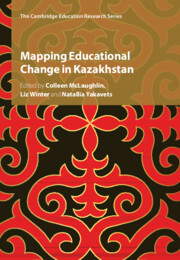Book contents
- Mapping Educational Change in Kazakhstan
- Mapping Educational Change in Kazakhstan
- Copyright page
- Dedication
- Contents
- Figures
- Tables
- Contributors
- Preface
- Acknowledgements
- Introduction
- Part I Foundations of Scaling Up
- Part II Piloting Initiatives and Scaling Up to the Whole System
- 6 Piloting the Renewed Content of Education
- 7 Revising the Content and Standards of Student Assessment
- 8 New Ways of Financing Schools
- 9 Professional Capacity of the Leading Schools as a Managing Mechanism in Updating the Content of Secondary Education in Kazakhstan
- 10 The Teacher Leadership in Kazakhstan Initiative
- 11 Developing Teachers as Researchers
- Part III Evidence of Implementation
- Conclusions
- Select Bibliography: School-Level Educational Reforms in Kazakhstan, 2011–2022
- Index
- References
7 - Revising the Content and Standards of Student Assessment
from Part II - Piloting Initiatives and Scaling Up to the Whole System
Published online by Cambridge University Press: 09 November 2023
- Mapping Educational Change in Kazakhstan
- Mapping Educational Change in Kazakhstan
- Copyright page
- Dedication
- Contents
- Figures
- Tables
- Contributors
- Preface
- Acknowledgements
- Introduction
- Part I Foundations of Scaling Up
- Part II Piloting Initiatives and Scaling Up to the Whole System
- 6 Piloting the Renewed Content of Education
- 7 Revising the Content and Standards of Student Assessment
- 8 New Ways of Financing Schools
- 9 Professional Capacity of the Leading Schools as a Managing Mechanism in Updating the Content of Secondary Education in Kazakhstan
- 10 The Teacher Leadership in Kazakhstan Initiative
- 11 Developing Teachers as Researchers
- Part III Evidence of Implementation
- Conclusions
- Select Bibliography: School-Level Educational Reforms in Kazakhstan, 2011–2022
- Index
- References
Summary
Chapter 7 provides a rationale and description of the main transformation processes in the content and standards for assessment of student learning achievements in Kazakhstan introduced within the Renewed Content of Education. Revision of assessment is a complex process that requires consistency with the socio-cultural context and well-structured communication to achieve its credibility. The presented assessment framework was intended to develop the internal structure and content of assessment based on criteria that could be reflected in improving learning outcomes, reducing disparity and building a sustainable culture of interaction based on transparent assessment mechanisms. As with any system, the assessment system depended on the integrity of its consideration and the interrelatedness of teachers’ actions in each classroom. Despite facing a problem of implementation complexity in the initial stages, the teaching community coped with the rethinking of the traditional approach and showed a willingness to develop its own methodological potential in assessment, which made it possible to expand the understanding and involvement of students, parents, politicians and society.
Keywords
- Type
- Chapter
- Information
- Mapping Educational Change in Kazakhstan , pp. 113 - 136Publisher: Cambridge University PressPrint publication year: 2023

